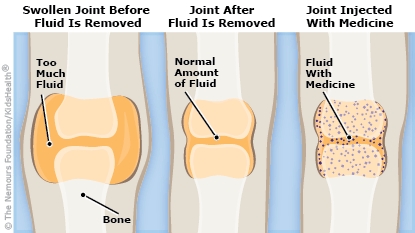After Intra-Articular Aspiration and/or Injection: How to Care for Your Child
Removing fluid from a joint or injecting medicine into it can help the joint move more easily, reduce swelling, treat pain, or help diagnose an illness.


Joints are where two bones meet, such as at the elbows, knees, shoulders, hips, and wrists. The area inside the joint (called the "intra-articular" area by health care providers) contains blood vessels and synovial fluid, which cushions the bones and acts as a lubricant to help them move easily.
In joint aspiration (also called "intra-articular aspiration" or "arthrocentesis"), a doctor carefully inserts a needle into a joint to remove fluid. A doctor usually does this to reduce pressure and swelling in the joint or to look at the fluid to diagnose a condition affecting the joint (such as arthritis).
In joint injection, the doctor uses a needle to put medicine — usually a corticosteroid (or sometimes a topical anesthetic) — in the joint. This type of medicine helps control pain and swelling. It takes a few days for injected corticosteroids to start working. Sometimes symptoms get a little worse until the medicine begins to work.
Joint aspiration and injection can be done together or separately. To prevent discomfort, the doctor may numb the area or give your child a sedative. Afterward, the joint is wrapped in a bandage.

-
Remove the bandage when your child goes to bed this evening.
-
For the 24 hours after the procedure, place a cold pack on the joint for 20 minutes every 3–4 hours while your child is awake.
-
If your child is uncomfortable, you may give acetaminophen. Do not give ibuprofen in the 48 hours after the procedure.
-
Your child may shower or bathe as usual.
-
Your child should do the range of motion exercises recommended by the health care provider.
-
Follow the health care provider's instructions about when your child should return to regular activities.

Your child has:
-
Redness or swelling around the joint.
-
A fever above 100.4°F (38.0°C).
-
Continued draining or bleeding from the injection site.
-
Pain that does not improve within 2 days.
-
Pain that is not relieved by acetaminophen or cold packs.